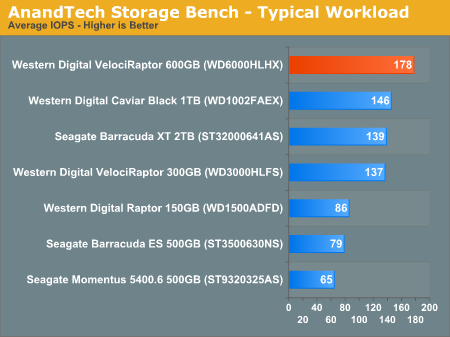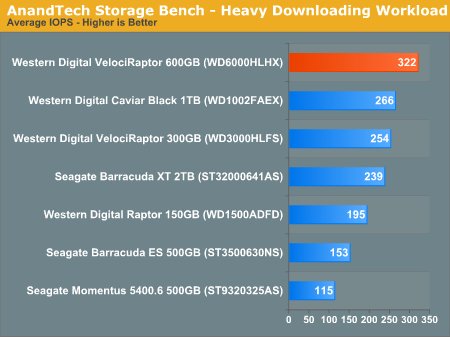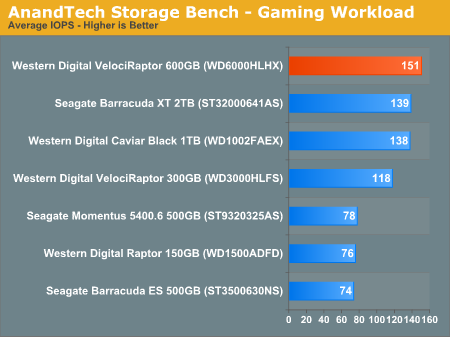Western Digital's New VelociRaptor VR200M: 10K RPM at 450GB and 600GB
by Anand Lal Shimpi on April 6, 2010 8:00 AM EST- Posted in
- Storage
AnandTech Storage Bench
The first in our benchmark suite is a light usage case. The Windows 7 system is loaded with Firefox, Office 2007 and Adobe Reader among other applications. With Firefox we browse web pages like Facebook, AnandTech, Digg and other sites. Outlook is also running and we use it to check emails, create and send a message with a PDF attachment. Adobe Reader is used to view some PDFs. Excel 2007 is used to create a spreadsheet, graphs and save the document. The same goes for Word 2007. We open and step through a presentation in PowerPoint 2007 received as an email attachment before saving it to the desktop. Finally we watch a bit of a Firefly episode in Windows Media Player 11.
There’s some level of multitasking going on here but it’s not unreasonable by any means. Generally the application tasks proceed linearly, with the exception of things like web browsing which may happen in between one of the other tasks.
The recording is played back on all of our drives here today. Remember that we’re isolating disk performance, all we’re doing is playing back every single disk access that happened in that ~5 minute period of usage. The light workload is composed of 37,501 reads and 20,268 writes. Over 30% of the IOs are 4KB, 11% are 16KB, 22% are 32KB and approximately 13% are 64KB in size. Less than 30% of the operations are absolutely sequential in nature. Average queue depth is 6.09 IOs.
The performance results are reported in average I/O Operations per Second (IOPS):

Performance in our real world benchmark however makes it very clear that no other hard drive is as fast as the 600GB VelociRaptor. WD delivers a nearly 30% improvement over the old drive, and 22% better performance than the new Caviar Black series.
If there’s a light usage case there’s bound to be a heavy one. In this test we have Microsoft Security Essentials running in the background with real time virus scanning enabled. We also perform a quick scan in the middle of the test. Firefox, Outlook, Excel, Word and Powerpoint are all used the same as they were in the light test. We add Photoshop CS4 to the mix, opening a bunch of 12MP images, editing them, then saving them as highly compressed JPGs for web publishing. Windows 7’s picture viewer is used to view a bunch of pictures on the hard drive. We use 7-zip to create and extract .7z archives. Downloading is also prominently featured in our heavy test; we download large files from the Internet during portions of the benchmark, as well as use uTorrent to grab a couple of torrents. Some of the applications in use are installed during the benchmark, Windows updates are also installed. Towards the end of the test we launch World of Warcraft, play for a few minutes, then delete the folder. This test also takes into account all of the disk accesses that happen while the OS is booting.
The benchmark is 22 minutes long and it consists of 128,895 read operations and 72,411 write operations. Roughly 44% of all IOs were sequential. Approximately 30% of all accesses were 4KB in size, 12% were 16KB in size, 14% were 32KB and 20% were 64KB. Average queue depth was 3.59.

Upping the number of writes doesn't change anything, the new VR is 26% faster than the old one and 21% faster than the best 7200 RPM drives. Keep in mind this is pure I/O performance, the real world performance is most likely in the 3 - 10% range on average which is what we saw in PCMark Vantage and SYSMark 2007.
The gaming workload is made up of 75,206 read operations and only 4,592 write operations. Only 20% of the accesses are 4KB in size, nearly 40% are 64KB and 20% are 32KB. A whopping 69% of the IOs are sequential, meaning this is predominantly a sequential read benchmark. The average queue depth is 7.76 IOs.

Sequential read performance is solid on the new VR, but not that much better than other, larger (and cheaper) drives on the market. Western Digital's advantage over the old VR is a healthy 27%, but over newer 7200 RPM drives it's barely 9%.










77 Comments
View All Comments
HotFoot - Tuesday, April 6, 2010 - link
People used to buy Raptors for the superior seek times. Where these drives were great was for loading programs. Throughput on large files isn't usually the consideration. RAID 0 does boost throughput, but increases seek time.But Raptors will never touch even the lowest-performance SSDs for random IO. These drives are completely obsolete as far as I can tell.
DanNeely - Tuesday, April 6, 2010 - link
Not quite completely, but the number of cases where a 7200RPM drive isn't fast enough, several hundred GB of high speed storage space is needed, and a $600-2000 sticker price for several SSDs is too high is much smaller than the raptor market was several years ago.I doubt we'll see a raptor revision after this one unless the cost of turning a SAS drive into a raptor is negligible.
marraco - Tuesday, April 6, 2010 - link
Worse, to match the storage capacity of the 450Gb raptor, you only need to use 10% of each 2Tb disk. This way you short stroke it, accelerating seek and random times.If you own an X58 chipset, you also may use the first partition as RAID0, and the remaining 90% space in RAID 0, or witouth RAID.
coolkev99 - Wednesday, April 7, 2010 - link
Not quite fair to compare the MSRP of a drive that's not even in the retail channel, to the discount OEM price of an existing drive.Belard - Tuesday, April 6, 2010 - link
Anyone else notice that "VR200M" is Subliminal Message to say "VROOM" as in fast? :)But these Raptors are simply not worth it any more. $330 for 600GB drive? Also they are the LOUDEST drives you can get over any other HD... and of course SDs wins hands down ag 0db.
The best setup is still the Hybrid SSD+HD for desktops.
$225 = 80GB intel X25-M G2 (Come on G3)
$ 85 = 1TB Seagate 7200.12 (On this review, Seagate are the quietest drives and its what I use)
$310 = Total for 1.08GB of storage that would dominate any Raptor.
synaesthetic - Tuesday, April 6, 2010 - link
No, not one 80GB X-25M.Two 40GB X-25V in RAID 0.
:D
Romulous - Monday, August 30, 2010 - link
You need to look at the point of the Raptor. Cheap, fast enterprise drives, which is a middle ground between sata and sas. I've setup several vsphere servers with 300GB raptors in raid 10 (8 drives) and they perform very well. Infact, even better than 8 15k sas drives in raid 5 on the same controller. For Virtual Machines, they work great. Of course this is no SAN thus no clustering is available.Xenoterranos - Tuesday, April 6, 2010 - link
Definitely glad I bought a 1TB caviar black. The performance benefits just aren't there given the loss in drive space, but for a high-end notebook, I could see it being a real competitor.AssBall - Tuesday, April 6, 2010 - link
.... Except that it is too tall to fit in notebooks.Glenn - Tuesday, April 6, 2010 - link
I bought into the first three generations of Raptors for the seek times. That is the single most irritating thing for me when using a higher performance computer. Damn HDs always slow everything down. I have migrated to SSDs now and will never look back.And often left unsaid in Raptor discussions, is their propensity to get noisier and noisier over there lifespan, to the point you think there are gremlins living inside your computer!